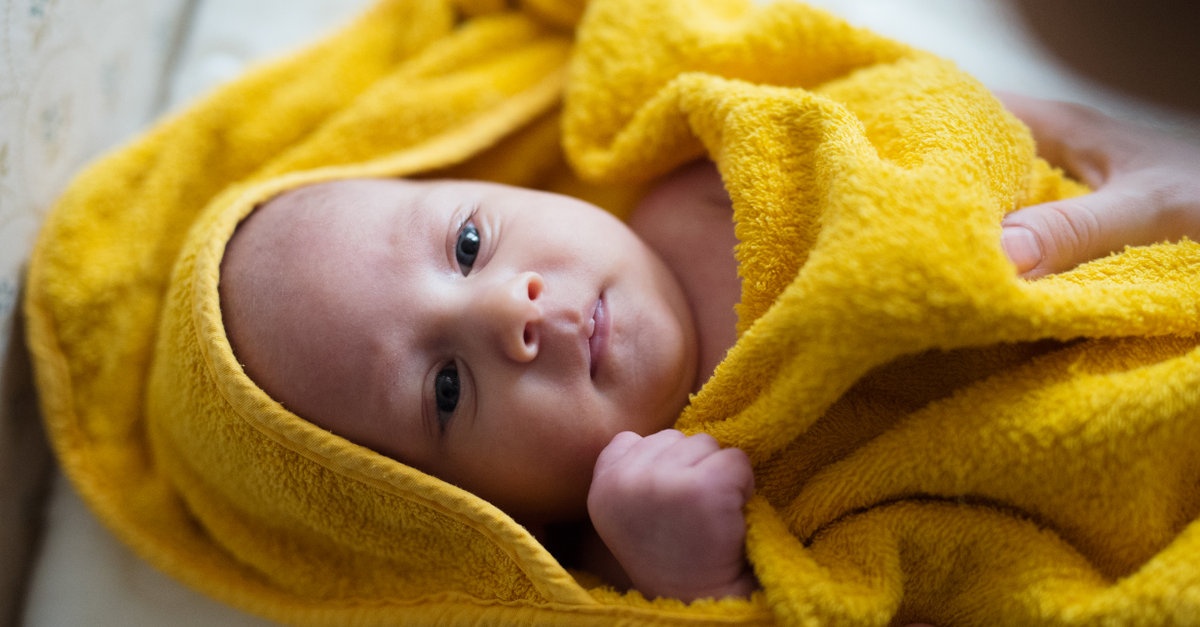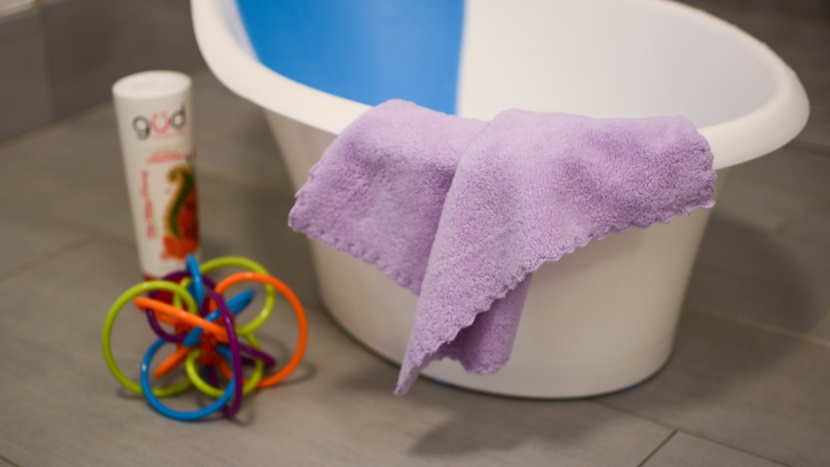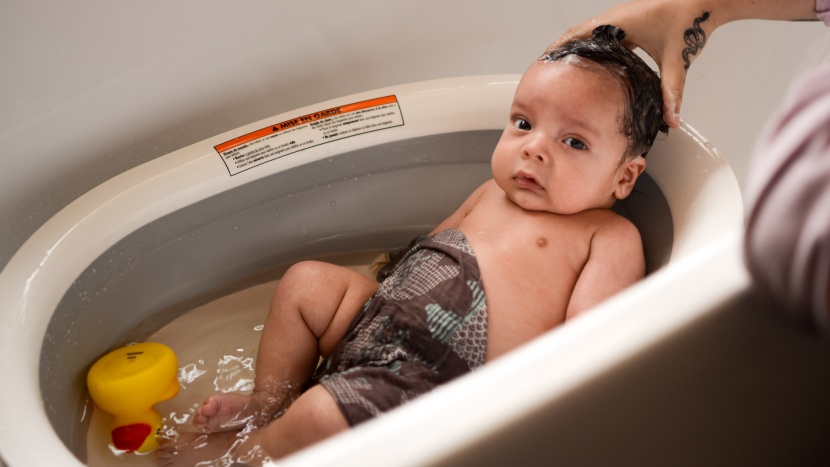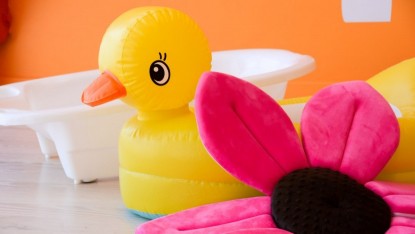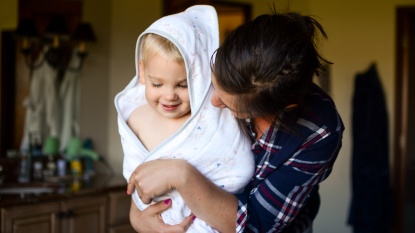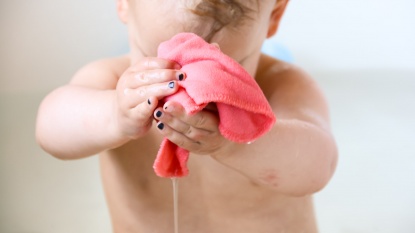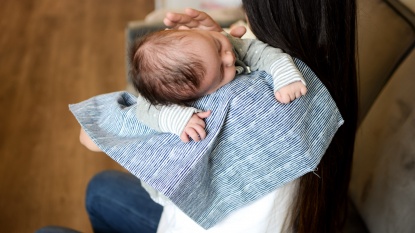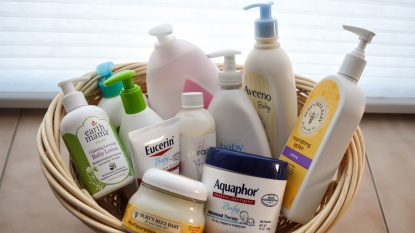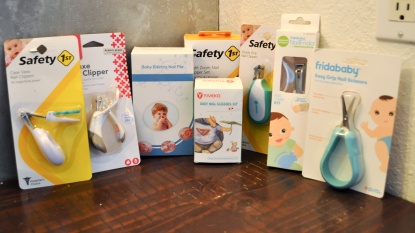Bathing your baby may not seem daunting until you try it. Yes, your sweet baby can be quite a slippery wiggle worm when wet, and it may take time to feel comfortable maneuvering them during bathing. The market is flooded with products designed to make bathtime easier, but it may be challenging to know how and when to use them and what aspects you should consider when getting your baby clean. For a quick breakdown, including tips and advice, read on.
Using a tub, like the Boon Naked, or sink insert designed for baby bathing will make juggling baby and bathing supplies easier. Credit: Abriah Wofford
Determine
- Frequency of Bathing - You don't need to bathe your baby daily. A few times a week or every other day is probably good enough, especially since your baby is getting a quick clean-up after every diaper change and feeding anyway. If your baby has any special needs, you might need to bathe them more often or pay particular attention to certain areas, so ask your pediatrician what schedule might be best for your baby.
- Time of Bath - Bath time is best when your newborn is well-fed and alert, which increases your chances of success. We also suggest choosing a time of day when you are not rushed and can focus on your baby without distractions. As your child grows, adding bathtime into your bedtime routine can be helpful as a warm bath is soothing and cues relaxation and sleeping.
- Location - Choose a safe location for bathtime. This location may be a specific baby tub independent of your standard tub or an insert inside your tub. Check out our review of baby bathtubs for recommendations.
Important
Avoid the countertop. Although some manufacturers market their infant tubs for countertop use, we strongly recommend that you do NOT bathe your baby on the counter or table. Countertop bathing has multiple potential safety hazards, including the tub falling off the high surface or the baby squirming out of the bathtub and falling. A 3-foot fall for a baby is like a 10-foot fall for an adult. A significant fall risks traumatic brain injury, skill or limb fracture, internal bleeding, or death. Given the variety of bathing options that offer a safer, more secure environment, there is no need to risk this.
Avoid the countertop. Although some manufacturers market their infant tubs for countertop use, we strongly recommend that you do NOT bathe your baby on the counter or table. Countertop bathing has multiple potential safety hazards, including the tub falling off the high surface or the baby squirming out of the bathtub and falling. A 3-foot fall for a baby is like a 10-foot fall for an adult. A significant fall risks traumatic brain injury, skill or limb fracture, internal bleeding, or death. Given the variety of bathing options that offer a safer, more secure environment, there is no need to risk this.
Prepare the Bath
- Temperature - Choose a water temperature between 98 F - 100 F (a temp close to body temperature). You can purchase a thermometer for the water or judge based on how the water feels on your wrist (not your hand). Always check to ensure that the bathwater is at a safe temperature before you place your baby in the water. Also, choosing a well-heated room is the best way to help your baby stay cozy during bath time rather than increasing the water temperature.
- Water Level - According to Mayo Clinic, you should start with two inches or less of water. Do not overfill or fill the bathtub to cover their entire body. This is not the time for your baby to enjoy a relaxing soak at the spa after a stressful day of work; they're there to get clean safely and quickly. Placing a warm baby washcloth on the baby's chest and tummy can help them stay warm. Gently pouring water on their body and cloth can also help.
Be Prepared
Collect all the supplies BEFORE getting your baby undressed. Grab a baby bathtub, a set of baby washcloths, a couple of our favorite baby towels, baby shampoo and body wash, and if desired, an unscented lotion or baby oil. Also, don't forget a fresh diaper and a clean outfit. Being prepared can reduce any stress. If you forget something and are alone, pick your baby up and take them with you. Never leave a baby unattended in or near water.
Collect all the supplies BEFORE getting your baby undressed. Grab a baby bathtub, a set of baby washcloths, a couple of our favorite baby towels, baby shampoo and body wash, and if desired, an unscented lotion or baby oil. Also, don't forget a fresh diaper and a clean outfit. Being prepared can reduce any stress. If you forget something and are alone, pick your baby up and take them with you. Never leave a baby unattended in or near water.
Bathing your baby can be daunting, but with practice and patience (plus deep breaths), you and your baby will have it down in no time. Credit: Abriah Wofford
Newborn Bathing
- Umbilical Cord Care - For the first couple of weeks, keeping your baby's umbilical cord stump clean and dry until it falls off (usually around one or two weeks of age) is important. Parents should start with sponge baths until this event occurs to keep the umbilical cord as clean and dry as possible. Contact your pediatrician if you have questions or concerns regarding your baby's umbilical cord site.
- One Hand on Baby - Be sure to support your baby's body as you slowly move them into the water, and keep one hand on your baby during bath time. This habit helps ensure that you are present and watching their every move. Bathing your baby can be a slippery situation, so keeping a hands-on process helps avoid potential injury.
- Cleaning - Undress your infant and lay them on a plush, soft cloth. Use a dry towel on their body to help them stay warm. Take a warm wet washcloth from the basin and work from head to toe, washing cleaner parts, like your baby's face and scalp, then finishing with genitals and bottom, which tend to be dirtier. Clean small sections at a time to prevent your baby from getting cold and distressed. Use a soap-free/new warm washcloth to rinse/wipe their body. Pay special attention to the skin folds and creases under the neck, ears, and armpits. Last, pat your baby dry with a baby towel that's soft and cozy before redressing them so they don't get cold.
- Baby Shampoo and Body Wash - Once your baby is ready for a mild soap, remember their skin is sensitive. We recommend using a top-ranked baby shampoo and body wash designed for babies and one that contains no ingredients of concern or strong fragrances, as this can increase the potential for skin irritations. Avoid using adult products on your baby, as they often contain harsh fragrances and chemicals that can irritate your baby's delicate skin.
Bath toys
Consider incorporating age-appropriate bath toys into your baby's routine as they age, which adds a splash of fun and play. Check out our review of bath toys for recommendations.
Consider incorporating age-appropriate bath toys into your baby's routine as they age, which adds a splash of fun and play. Check out our review of bath toys for recommendations.
Reference Sources
- Mayo Clinic - Baby Bathing
- Healthy Children - Bathing Your Baby
- Healthy Children - Umbilical Cord Care

